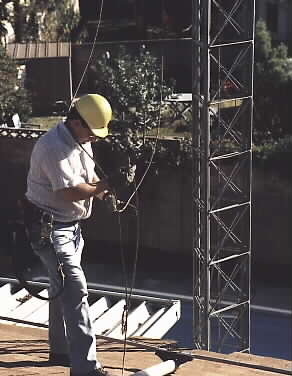
Preparing to climb
If you have not had instruction in safety procedures, suffer from acrophobia, or do not have the proper safety equipment, hire someone who does!
You must have the following equipment to safely climb and work on a tower: a properly fitted OSHA approved safety belt and pole strap, hard hat, leather gloves that fit correctly, and boots. Be sure you inspect your equipment, following the manufacture's recommendation before each use. As with all antenna and tower work, know the location of possible overhead hazards and power lines in advance. If you are unsure, do not climb. Verify with a structural engineer that the tower is capable of supporting your weight along with all apparatus you will use and add. Never climb a tower in windy conditions as the additional wind loading of your body could over stress the structure. Always keep three points of contact; i.e., both hands and one foot or one hand and both feet must be firmly planted on the tower at all times.

Preparing to climb
Before raising the antenna, I did the following preparatory work on the tower: 1) install the rotor, 2) raze and attach a gin pole to the side of the tower, 3) install the antenna mast and secure it in the rotor.
Since I have previously discussed the rotor installation, I will move on to the gin pole. A gin pole is a type of hand operated crane. The two most common varieties that hams will encounter are the a-frame types used to raze large towers and the type attached to the tower itself to raze and lower antennas and other objects. The gin poles sold by tower manufactures cost well over $100. They usually have a winch mounted on the gin pole to aid in raising and lowering objects. Today, many amateur radio stores will rent or loan gin poles. That was not the case when I first put up my tower, so I made my own for $15.
My gin pole consists of a 2" x 3" x 10' fur stud with two u-bolts to attach it to the tower legs along with a block and tackle attached to a screw in eyebolt at the top. It works very well. To install it, I climb the tower and hoist it with a rope. I then attach the u-bolts. The top of the gin pole should be above the top of the antenna mast. My gin pole is a little short, but I have a light weight antenna. Since my gin pole uses a block and tackle, assistance on the ground is need to pull the rope.
CAUTION: Do not use a conventional length of pipe as a mast unless the antenna will be mounted no more then a foot above the tower's top plate. Long masts must not only support the vertical weight of the antenna, but must also handle the wind loading and, as you can see in the photograph, your own weight. Masts supplied by tower manufactures are double, and sometimes, triple walled to prevent bending, conventional pipe is not. If possible, avoid installations where the rotor is on the top plate with the rotor bearing both vertical and horizontal loading forces.
Installation of the mast was easy. the mast was pulled to the top of the gin pole and then positioned vertically over the mast hole in the tower's top plate. It was then lowered into the rotor and bolted in place. The rotor cable was brought up through the center of the tower and wired to the rotor. It is very important to secure the cable to a tower vertical member in a manner that will provide strain relief to the wires on the rotor.